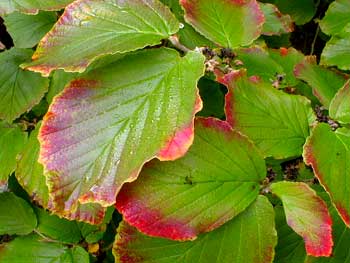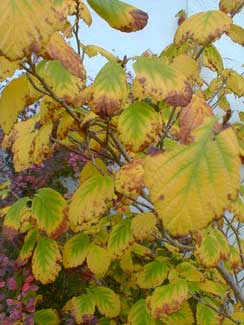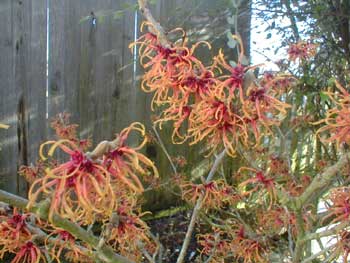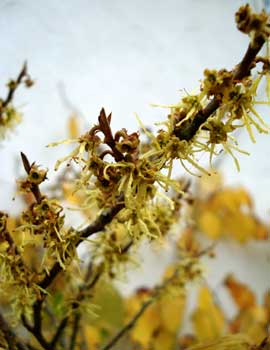
Medicinal Uses of Witch Hazel
"Lost in the forest, I broke off a dark twig
and lifted its whisper to my thirsty lips:
maybe it was the voice of the rain crying,
a cracked bell, or a torn heart."
-Pablo Naruda
(1904-1973)
(1904-1973)
For centuries the leaves & bark of Hamamelis mollis in China, H. japonica in Japan, H. virginiana in North America (its autumn leaves shown below left), & even the Asian hybrid cultivars H. x intermedia (as shown above right at the start of its autumn leaf color, & lower on the page in winter flower) have all been used medicinally.
Though an awful lot of purported herbal remedies are total frauds, there is no doubt that witch hazel is an effective natural pharmaceutical. That said, one must also bear in mind that the pharmaceutical qualities aren't much retained in the stale dried out powdered bark & twigs sold commercially for what ails ya, even though the fresh stuff from your own garden can be more sensibly regarded as medicinal; & extracts correctly preserved are valid ingredients in actual medicines which do have to meet a minimal requirement for pharmaceutical products, which cannot be said of herbs found in health food stores which only have to meet the lesser legal standard of "food supplements."
 If you check the packaging of nearly every other herbal remedy on the American market, most will nowhere on the package claim actual medicinal value, because generally they have none. There may be a placebo effect for whatever the buyer superstitiously has come to believe from hearsay or freedom-of-press promotional pamphlets & books which lie like the devil. If pressed for details the packagers or manufacturers will be forced to admit they sell only food supplements, not medicines, despite that people are encouraged to buy & use them as medicines.
If you check the packaging of nearly every other herbal remedy on the American market, most will nowhere on the package claim actual medicinal value, because generally they have none. There may be a placebo effect for whatever the buyer superstitiously has come to believe from hearsay or freedom-of-press promotional pamphlets & books which lie like the devil. If pressed for details the packagers or manufacturers will be forced to admit they sell only food supplements, not medicines, despite that people are encouraged to buy & use them as medicines.But witch hazel has explicit & proven values & is one of the few herbal or natural remedies to have passed muster federally & obtained the approval of the U.S. Food & Drug Administration to be sold specifically for medicinal use. Peparations are legally sold in ointments for small cuts & injuries, pads for hemorrhoid relief, in addition to remaining significant as a distillate in toiletry products.
The leaves & underside of the bark contain tannic & gallic acids, besides proanthocyandins that have antiphlogistic (swelling-reducing) properties. Native Americans used it to relieve the pain, swelling, bruising, & bleeding of external injuries.
The tannic & gallic acids are the "astringent" component that made witch hazel tincture one of the very first commercial toiletry products manufactured for wide distribution in Victorian America, used as body-splash, after shave, or to treat minor burns & abrasions. In our great-grandparents' day, commercially manufactured witch hazel ointments & suppositories & tonics were a staple of American medicine cabinets. Its early history as the very first commercially manufactured American toiletry product is told on the primary American Witchhazel page.
 It is no longer recommended to imbibe boiled leaves & twigs for internal use, as the tannins are toxic to kidneys & liver. But in the past, a tonic tea made from young leaves was recommended for its ability to retard internal bleeding from ulcers. Though this is now known to be unsafe, in days of the pioneers, when witch hazel was used for internal injuries, or freshly harvested & applied to emergency injuries with compression to stop bleeding, it must have saved many a life when physicians or hospitals were long journeys away.
It is no longer recommended to imbibe boiled leaves & twigs for internal use, as the tannins are toxic to kidneys & liver. But in the past, a tonic tea made from young leaves was recommended for its ability to retard internal bleeding from ulcers. Though this is now known to be unsafe, in days of the pioneers, when witch hazel was used for internal injuries, or freshly harvested & applied to emergency injuries with compression to stop bleeding, it must have saved many a life when physicians or hospitals were long journeys away.Distillate witch hazel does not have the tannins, thus is so close to harmless as to be safely used as a mouthwash or treatment for ailing gums & inflammation of the eyes, even if still not wisely swallowed. Though very useful as a prophylactic mouthwash, it will cure no periodontal problems, it will only help prevent them.
The fact that it is definitively useful for some things does not make it wisely used willynilly for all things. It has been used orally for ulcers, vericose veins, circulatory or gastrointestinal problems, or used vaginally for absesses & venereal diseases; indeed, for all sorts of things that doubleblind studies have been unable to substantiate. Because it it harmful to the liver, it is nowadays known not to be recommendable for internal use. It gets used internally anyway, unfortunately, & instructions on how to make a tea for use as enema, douche, or tonic tea are easily obtained, together with reckless recommendations.
Vaginal cleansing with tincture of witchhazel is a centuries-old midwife remedy. Although witch hazel or oak extracts & teas might indeed have anti-inflammatory capacity if so misused in douches or enemas, any benefit would be greatly offset by the potential harm from tannins, & its curative value with such misuse would be none whatsoever, whether or not there were temporary relief from its ability to momentarily shrink tissues. Steam distillate witch hazel lacks the dangerous tannins, but is not effective, nor wisely tried as douches or enemas, & the commercial preparations in liquid form nowadays state that they are not for any internal uses.
 Though enemas are unsafe, rectal suppositories which have witch hazel as their active ingredient, in a cocoa butter base, meet the FDA's criteria for safety & efficacy. They are manufactured for hemorrhoid sufferers, or for relief of minor rectal bleeding during pregnancy. In general, an external cream is preferrable to suppository. For external stinging hemorrhoids, a witch hazel wipe pad, or dab of ointment, is more than sufficient.
Though enemas are unsafe, rectal suppositories which have witch hazel as their active ingredient, in a cocoa butter base, meet the FDA's criteria for safety & efficacy. They are manufactured for hemorrhoid sufferers, or for relief of minor rectal bleeding during pregnancy. In general, an external cream is preferrable to suppository. For external stinging hemorrhoids, a witch hazel wipe pad, or dab of ointment, is more than sufficient.Witch hazel suppositories are incorrectedly recommended for constipation. A physician should be consulted before using suppositories, especially so for the elderly, children, or pregnant mothers; it is in general a bad idea to use any herbal remedies as an end-run to avoid physician consultation. Hemorrhoid sufferers can also gain relief from home-brewed teas, chilled, in a pan large enough to sit in. Any time relief is not achieved by these methods, a doctor should be informed at once.
Witch hazel ointments, pads, tea washes, & distillates exclusively for external uses are completely safe & have specific values. Extracts of witchhazel contain chemical components with antimicrobrial & antibacterial activity. It is proven most useful as a topical ointment for mild sunburn & dermatitis. In doubleblind studies it is proven not to relieve itch from insect bites, but it does have its anti-inflammatory value for other skin problems, & can help prevent bacterial infection of irritated skin.
Research studies have found that for severe skin conditions it is not as effective as hydrocortisone ointment, but neither is it ineffective, & for milder conditions, it is quite reasonably a first choice of treatment.
In sum, witch hazel's usefulness encompasses topical ointments for mild sunburn, hemmorrhoid pad wipes or suppositories, distillate mouthwash, or home made teas used as body wash for skin conditions. These make witch hazel one of the more credible herbal remedies. The myriad of additional medicinal values alleged for it are by & large unsafe or inneffective or both.